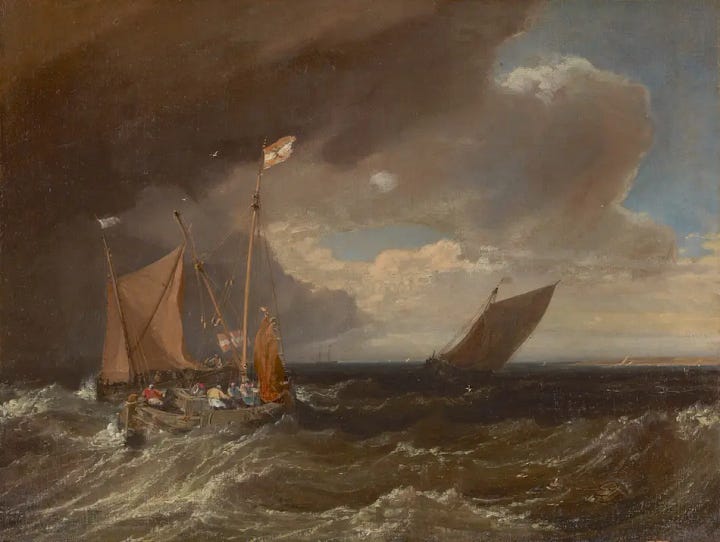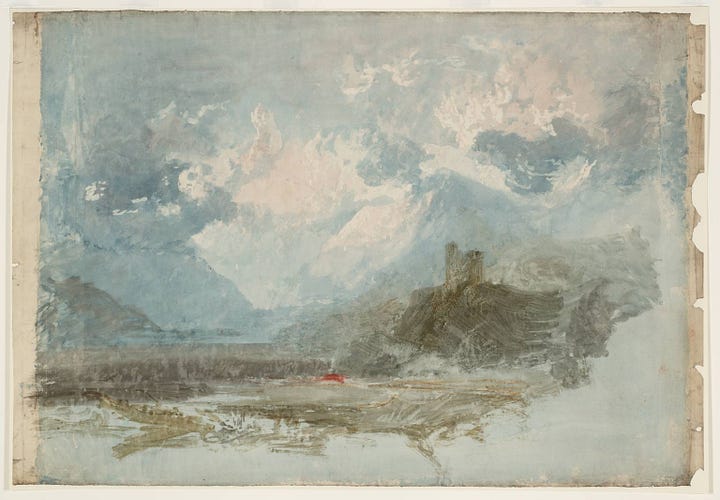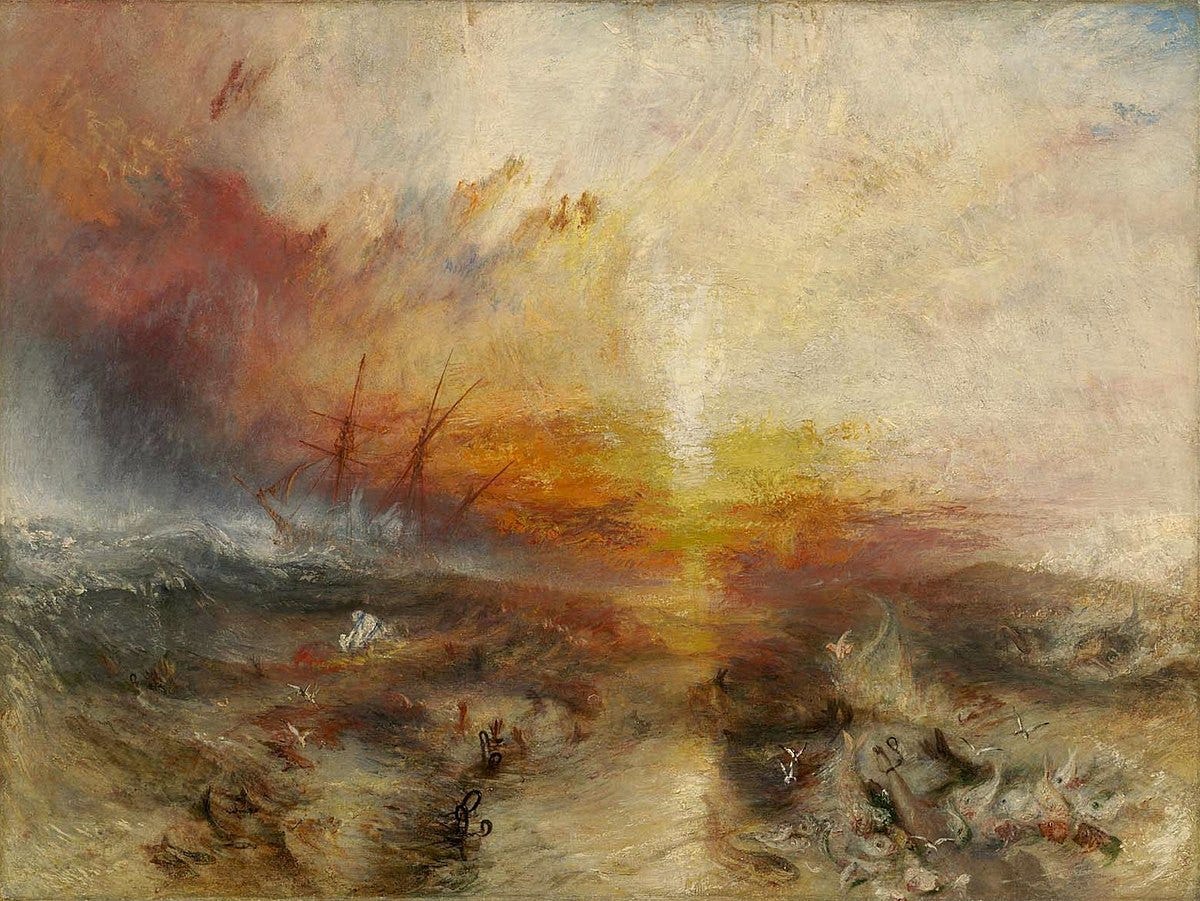Notice: I’m presenting a pay-what-you-can online talk next week about Great Lost Masterpieces of European Art! It will be on Zoom at 7pm BST on Tuesday 29th April, book your ticket here: Zoom Talk!
Joseph Mallord William Turner was born on St. Georges Day 1775 above his father’s barber shop in Covent Garden, the artistic and theatrical district of central London. That makes 2025 the 250th anniversary of his birth and with books, events, and exhibitions around Britain and beyond, the world is marking this milestone. Britain has never been very good at celebrating its artists. Explorers like Cook and Scott, scientists like Newton and Watt, even politicians like Gladstone and Churchill are readily trumpeted, taught in schools, and the subject of Ladybird books. But Turner might be the exception, he has been the most celebrated British artist since his death in 1851 to the obliteration of almost anyone else. He is regarded as a fundamental figure in British art finding its own identity after centuries of bending to foreign influence, he is the subject of feature films, novels, and even appears on the £20 note in your pocket.
In 2005, French-Moroccan art historian Olivier Meslay declared Turner “the man who set painting on fire.” The same year saw his Fighting Temeraire win the accolade of Britain’s best-loved painting after a mass survey of the populace. Grand claims have been made for this diminutive cockney artist, even in his own lifetime his reputation was enough to earn him burial in the crypt of St Paul’s Cathedral, alongside Nelson and Wellington, only the third artist to be given such an hour after Wren, the building’s architect, and Reynolds, the first president of the Royal Academy. But in this anniversary year, let us take a step back and try, at least, to view Turner’s work objectively, and see if he lives up to his own hyperbolic reputation.
His career began ordinarily enough, cashing-in on the blooming British tourist trade at a time when overseas travel was made difficult by the French revolution, and latterly Napoleon. The late 18th and early 19th centuries saw the British discovering the romantic beauty of their own landscape for the first time, travelling to the Peaks, Lakes, Wye Valley, and North Wales in search of the picturesque - literally views like they’d seen in pictures. The young Turner, alongside Thomas Girtin and other artists travelled across Britain churning out small watercolours of picturesque views - ruins, cathedrals, tumble-down villages, mountains and lakes - which would later be mass-reproduced as affordable prints. Often bound into books with accompanying travelogues, these were the holiday guidebooks of their day. His early topographical works of this kind are derivative, but a certain natural talent shines through, and eventually Turner won a place at the RA schools.
The oil paintings he produced in the final years of his diploma are nothing especially remarkable for the time. Images of castles in Wales and river valleys in Cornwall which owe their inspiration to Claude Lorrain and in turn the Welsh father of British landscape painting, Richard Wilson. The scenery is exaggerated but not overly sublime, there is usually a central focal point of a castle tower or a viaduct, and then as small cast of bucolic stock characters in the foreground - fishermen, shepherds, cowherds etc. At the same time he is producing seascapes in the idiom established a century earlier by Anglo-dutch painter Willem van de Velde the Younger. He knows these will sell for a good price in a strongly maritime nation in the era of Nelson, and he clearly has a natural aptitude for depicting swirling currents and bucking ships caught in violent coastal gusts. These works are the first time that Turner does battle with the elemental forces of nature, and he comes out on top.


The Turner we recognise today is further down the road, but signs of his coming can be found in the sketches and preparatory watercolours the young artist made for these early attempts in oil paint. Take, for example Dolbadarn Castle, 1800, a moody image of a mountaintop castle ruin in North Wales, which Turner painted as his diploma piece to graduate from the RA schools. Whilst competent, it is not especially atmospheric, overall it is dark brown and generic, with vague passages in both the foreground and backdrop. However, contrast this with the sketch, produced on-site by Turner in a sketchbook, and we start to see a recognisable Turner-ish idiom emerging. Where another artist might use a sketch to plot out simply and clearly the fundamental forms in the view, Turner documents instead the atmosphere of the vista, full of mists, swirling clouds, and light. The distinctive castle tower can be picked out, but otherwise it is all sensational in the literal sense.


The break in Turner’s career seems to have come in the early 1830s. We see its arrival in works like Ulysses Deriding Polyphemus, which whilst in subject matter remains traditional, the colours depart from convention with fiery aplomb. This is the first of the Turner sunsets which will become legendary in art history. The textually rough impasto passages, full of white, orange, and red, appear in the sky and water, in unity with the rich gold and crimson of the galleon in the foreground. The sheer luxury and indulgence of this painting sets it apart from anything British art had seen before, but deeper than that, there is an intensity of atmosphere and a foregrounding of sensation that are new.
Timing could not have been better for Turner when the archaic complex of Thames-side buildings which had housed parliament since the middle ages burst into flames in 1834. The Palace of Westminster fire destroyed nearly all of the pre-Victorian Houses of Parliament, miraculously leaving only the medieval great hall standing. Along with thousands of Londoners, Turner watched the inferno from the opposite riverbank, even venturing onto the waters in a small boat, and crossing to get as close to the fire as he could. The sketches and watercolours he made that evening were worked up into two grand oils recording the fire. One closer, taking the view from directly across the river, alongside Westminster Bridge, the other, a more panoramic vista from downstream, clearly showing the wind blowing smoke and flame across the water, and crucially away from the perilously located Abbey in the distance. Fire, steam, and water, Turner’s favourite conditions give him his moment, these works put us amongst the crowd on that night, the thick paint applied roughly with a palette knife with the same violence which sky-licking flames had on that fateful evening. The Palace itself, scarcely visible in the works, appears as finials and gable-ends momentarily emerging from the conflagration, fire glimpsed through the burning tracery of empty gothic windows.
The Westminster fire paintings set the tone for the second-half of Turner’s career, and prefigure the three great works that Turner will complete over the next decade; The Fighting Temeraire, Snowstorm: Steamboat of a Harbour’s Mouth, and Rain, Steam, and Speed: The Great Western Railway. Without these three works, regularly voted amongst the UK’s favourite paintings, Turner would not have the reputation he holds today. Like most great works of art, each one pushes the boundaries of painting a little further out, each work opens up more room for creative expansion into virgin territory for artists everywhere.
Temeraire might be the national favourite, but for me it is Rain, Steam, and Speed which is the most exciting and radical. It is easy to forget the seismic changes British society had seen in the first half on the nineteenth century, as William Gaunt observes in his survey of English Painting : “[Turner] began life…as a young topographical draughtsman in the age of the stagecoach, and ended as the most unconventional of painters in the age of the railway.” He lived in four different reigns, was born before both American and French revolutions and died in the year of The Great Exhibition. His life spanned from powdered wigs and knee breeches to top hats and trousers, from the world of Jane Austen to the pages of Charles Dickens. Rain, Steam, and Speed is the first ever oil painting of a railway engine, a technology as new to Turner as the iPhone is to us.
If Turner’s late style is all about transforming forces of nature - fire, water, wind, light - into colour and texture, then Rain, Steam, and Speed is the moment these forces are harnessed by man in a way that rivals nature for the first time. The bottle-nosed steam locomotive vomits forth glowing cinders and ash as it hurdles towards us out of the thick textural mist of drizzle and steam. The man-made train, and Brunel’s newly built bridge across the Thames at Maidenhead are the only solid and tangible forms in the work, thrusting out of the fog towards us, a grand gesture of human intervention in nature. Turner makes the radical choice to obscure the horizon, we are aware of sky and earth, but the point where they meet is left vague, because this is not an illustration, but a representation of experience, an impression of a moment.
The title is the give-away, rain, steam, and speed are the subject of the work, the ‘Great Western Railway’ after the colon is incidental. Turner is not trying to paint a picture of a train on the bridge, but rather the sensations generated by this never-before-seen combination of natural conditions and human invention. Before Turner, the idea of an artist painting a work with a primary subject as abstract as the concept of ‘speed’ would be unthinkable - after Turner, the translation of a subjective response to the world of sensation into something tangible and objective would become one of the primary ambitions of artists everywhere. (Incidentally, the ‘speed’ he is painting was certainly no more than 30mph.)
Turner opens the door on a new world of subjects to be painted, a baton which, thirty years along the line, will be taken up by the Impressionists in Paris. Thanks to Turner’s bequest of many of his greatest works to the British nation, there can be little doubt that Monet and Pissaro saw his works when they lived in London in the early 1870s. Monet’s images of the Thames, painted from his Savoy Hotel room during the 1890s, especially those of Waterloo Bridge, are unthinkable without Turner’s before him.
Turner and the Impressionist might share an idiom, but they also share its limitations. Whilst Turner was clearly a man of convictions and sympathy with those less fortunate, his late style cannot successfully convey specifics of narrative, nuance of emotion, or political meaning. ‘Slavers Throwing overboard the Dead and Dying—Typhon coming on’, 1840, is a beautiful painting, full of the intensity we come to expect from Turner, as well as a cast of his usual characters - a blazing sunset, a stormy sea reflecting its light, a majestic ship bucking on the waves - so much so that we do not notice at first the darker side of this particular work. A story of ill African slaves being thrown over the side by a beleaguered slave ship reported in the London press animated Turner to depict the event in order to raise awareness of the terrible plight, but there could not have been a painter alive in England less suited to this kind of journalistic painting. Our eyes are naturally drawn to that glorious sunset, so we don’t see the black manacled hands disappearing beneath the waves, and when we do eventually spot the leg being devoured by fish in the foreground it strikes an almost comic note by its incongruity - not the pathos that the subject deserved or that Turner was trying to achieve.
In his 250th year, we can look back on Turner as an artist who carried British painting forward from the traditions of the eighteenth century into something better suited to represent a changing, modernising world, both in terms of technology and the breadth of human experience. It may be precisely because of the originality of his genius that the British artists who came immediately after him shied away from his most abstract gestures. The latter half of the nineteenth century was dominated in Britain by the clinical finish of the Pre-Raphaelites and their twee narrative Victorian moralising. But the legacy of Turner can be seen in the Hudson River School painters of the young United States, the Impressionist radicals in Paris, and even in the Abstract Expressionist school of painters, a century after his death. British art, however, has never quite recovered from its surprise that JMW Turner happened to be born an Englishman.
Happy 250th, Turner, and thank you for reading! If you’re based in or near Cardiff, I’ll be lecturing on Turner over the next couple of months at both The Turner House Gallery and as part of the Llandaff Cathedral Festival, you can find details of those events when available Here!
If you enjoyed this short essay on Turner please remember to ‘like’ and ‘share’! Subscribing also really helps, you can do this free of charge so you never miss a post! Or if you are able to please consider a paid subscription option to help support my research and writing here, its less than the price of a coffee per month!








